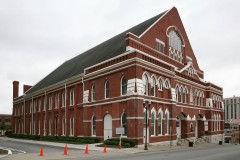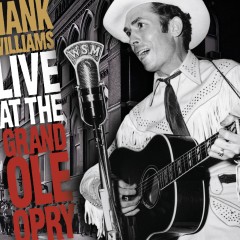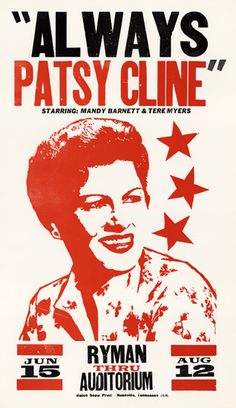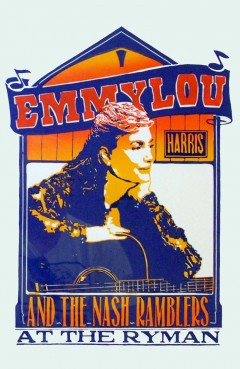Tales From The Road
THE GRAND OLE OPRY: The Ryman Years, 1943-1974

The Ryman Auditorium



This is a tale of two historic country music institutions. Often, they have been confused as one and the same. The Grand Ole Opry is the long running radio show in history. The Ryman Auditorium is where the Opry called home for 30 years. Today, the two are still closely related in the public mind. The two institutions are like a hometown family who have endured despite conflict, controversy, instability, and financial struggle. However, remember this: the Grand Ole Opry is a radio show; Ryman Auditorium is the place where the show was held for 30 years. But, the two will always be intertwined as important branches American country music.
The Grand Ole Opry, which will celebrate its 90th year in November as a Nashville-based radio program, has several distinctions that make it something to honor and celebrate. It is one of America’s oldest music institutions. It is the longest running radio show in the world. The Opry, broadcast on station WSM, has helped launch the careers of countless country music legends, including Roy Acuff, Kitty Wells, Bill Monroe, Hank Williams, Patsy Cline, Loretta Lynn, and Johnny Cash. In country music today there is still a sense of pride to be invited to join its elite membership.
Then there is Ryman Auditorium, so often referred to as the Grand Ole Opry or the Opry House. At 123 years old, standing in the heart of Nashville, it is one of America’s oldest enduring halls of music and entertainment. However, it was not built for secular pleasure. It was first built as a religious venue — a Protestant church devoted to revival meetings. It eventually became the cultural hub of early twentieth-century Nashville. Because of its years as the home of the Grand Ole Opry, the vintage building is today commonly referred to as “the Mother Church of Country Music.”
When the Grand Ole Opry resided in Ryman Auditorium from 1943 until 1974, it was a far from perfect union. The Ryman had only one dressing room, no air-conditioning and, not long after moving in, could not meet the audience demand for the Opry broadcast. However, it was during those years the show grew into a nationally popular entertainment, paving the way for the world outside of the Deep South to experience country music for the first time. Today it is known as the show that made country music famous.
The Opry’s premier broadcast took place on November 28, 1925. An obscure AM Nashville radio station, WSM, which was created primarily to sell insurance, booked a show produced by a broadcaster who introduced himself as “Judge Hay” (aka George Hay). He called it the WSM Barn Dance. He wanted to bring to the air waves old time music featuring fiddles, guitars, and singers of folk ballads. His first guest on the show was a 78-year-old fiddler named Uncle Jimmy Thompson; the show was a hit. It soon became a fixture every Saturday night.
How did the Opry get its name? In 1927, then two-year-old WSM Barn Dance went national when it was scheduled to follow NBC’s Music Appreciation Hour, a radio broadcast devoted to classical music and grand opera. Old Judge Hay considered the contrast between the higher brow music of the preceding show and the earthy, authentic music he was about to present. He then introduced the first artist to appear on the nationwide broadcast of the show: “Harmonica Wizard” DeFord Baily. The musician played a stirring and engaging song about passenger trains called “The Pan-American.” After Baily finished, Hays announced, “For the past hour we’ve been listening to music taken largely from the Grand Opera. From now on we will present the Grand Ole Opry. The name stuck.
Among the first performers to play during the ’20s were banjo player and comedian Uncle Dave Macon, the Crook Brothers, the Brinkley Brothers & Their Dixie Clodhoppers, and Ed Poplin & his Barn Dance Orchestra. By the 1930s the show began broadcasting at 50,000 watts, allowing it to be sent all over the United States. In 1939, the show was picked up by NBC for a regular nationwide broadcast.
However, by 1942 the Opry show had outgrown five of its previous homes. WSM began looking for something more permanent.
Enter Ryman Auditorium, which was completed in 1892. It was built by a riverboat captain and magnate, Thomas Green Ryman. After attending a tent Christian revival meeting with the intention of heckling the preacher, he was converted. Ryman became a fervent believer. He was so zealous, he decided to build a large auditorium to replace the rugged revival tents endured by the crowds over the years. Upon completion in 1892, the building was named Union Gospel Tabernacle in order to brand its holy intentions. It took another five years to build the balcony, which was completed just in time for a meeting of the United Confederate Veterans. Today, the balcony is known as Confederate Gallery. Although several times Nashville businessmen and politicians tried to name the hall after Thomas Ryman, he refused to allow it. However, upon his death in 1904, it was officially named Ryman Auditorium.
After Ryman’s death the building was still used for religious purposes, but it remained dark most of the time. Due to financial strains, it was soon leased by a single-parent and widow-turned booking agent/promotor, named Lula C. Naff. She was not just an ordinary business lady. She was a feisty entrepreneur and visionary. She used the hall for commercially viable events, such as speaking engagements, concerts, boxing matches, and plays. As the religious services made a final exit, the auditorium became a cultural center for Nashville. Naff oversaw the booking of sought-after lecturers as well as major celebrities and entertainers. The famous names who graced its stage could easily read like a Who’s Who in American history. Included in its impressive roster during the pre-Opry years at the Ryman include W.C. Fields, Will Rogers, Charlie Chaplin, Bob Hope, Harry Houdini, John Phillip Sousa, Presidents Theodore Roosevelt and William Taft, Helen Keller, and Anne Sullivan.
But, Lula Naff was also an activist. Accordingly, she was a force to be reckoned with in a legal battle. During her tenure, she took on the local censors as well as racist Jim Crow laws and she won. While many of the shows in the South were segregated, Naff defied the law and allowed for integrated mixed-race attendance to shows. The fact that it became the regular venue for the Fisk Jubilee Singers — a famous vocal group from the local all-black college — speaks volumes of how progressive Neff’s booking practices were during the years when racism was the rule of law.
Meanwhile, in 1943, the Grand Ole Opry, suffering severe growing pains, found its home at Ryman Auditorium. The move opened the door to the Golden Age of Country Music. Over the next 30 years The Opry at Ryman Auditorium saw the debut of some of the most important artists in country music history. To name a few: in 1945, Bill Monroe and his Blue Grass Boys debuted their new banjo player, Earl Scruggs. In 1949, a 25 year-old singer-songwriter named Hank Williams took the stage and sang “Lovesick Blues.” The audience called him back for a record-breaking six encores. In 1954, before he broke out nationally, Elvis Presley performed at the Opry. In 1956, Johnny Cash became a member, and it was backstage at the Opry where Cash met his future wife, June Carter. In 1960, Patsy Cline became an Opry member and brought a new kind of country class to the show when she sang her hit song, “Crazy,” written by a young Texas DJ named Willie Nelson.
In 1969, when Johnny Cash was riding the top of the charts with his successful cross-over album Live at San Quentin, he was given a television show to be taped before a live audience. He insisted the show be broadcast from Ryman Auditorium. His guests included Bob Dylan, Louis Armstrong, Eric Clapton, Carl Perkins, Linda Ronstadt, Joni Mitchell, and Pete Seeger.
At the same time, the Grand Ole Opry had been moving along every Saturday night at the Ryman. But, the show had long before outgrown the hall. With no air conditioning and only one dressing room for performers, the auditorium became a kind of hell for its stars. Even the most famous acts were known to wait in the wings before going onstage — with little backstage area available. Many of the performers walked down the block to Tootsie’s Bar to wait for their time to go on. When tourists came to town, they knew to go to Tootsie’s to meet up with Tom T Hall, Waylon Jennings, or Farron Young. It was because they preferred the bar to waiting in the wings at the non-air conditioned Ryman.
The crowds and demand for tickets continued to be a problem. By 1974, the Grand Ole Opry said farewell to the Ryman in favor of moving into their own new, modern home. While it was a parting that made sense, it was also bittersweet for audiences and performers who had lived out so much history at the beloved hall. Comedian Minnie Pearl openly wept during the final show. Roy Acuff was relieved. He didn’t like the hall. Many years before its closing, he even rented a building for his own dressing room across the street from the Ryman
The Ryman lay dormant for years following the 1974 Opry exit. As the show grew to even greater heights of popularity, its old home of 30 years was being threatened with demolition. The radio station, WSM, proposed tearing it down and use its bricks for a prayer chapel in their new amusement park, Opryland. The management of the Grand Ole Opry feared the building still standing would take away business from their new and expensive Opry house.
The fact that it was registered as a national historic site in 1971, after several political battles were waged for and against its destruction, ultimately saved the building from demolition.
With the rumblings of possible demolition still in the political air around Nashville in the decades that followed, it took a country music icon to turn things around. In 1991 and 1992, Emmylou Harris and the Nash Ramblers recorded a live album during a series of concerts at the decaying hall. Her intent was to raise the money to help save the building. The critical and popular acclaim for the album revived interest in the auditorium. In 1993, Gaylord Entertainment restored the old building back to its original glory. And with the restoration came air conditioning. Today, the Ryman is host to a full calendar of top-draw concerts throughout the year. It is also home to the annual Americana Music Honors and Awards show staged by the Americana Music Association, which includes performances by artists like Buddy Miller, Rodney Crowell, Jim Lauderdale, and, of course, Emmylou Harris.
Appropriately enough, the first show at the new Ryman was a broadcast of Garrison Keillor’s A Prairie Home Companion. Ironically, Keillor told his audience that he was inspired to create Prairie Home Companion when he was reporting on the final Opry show at the Ryman in 1974.
Today, the Grand Ole Opry thrives in its new home with all of the modern conveniences that were lacking at the old Ryman Auditorium. The show is now internationally famous. It continues to introduce new talent as well as give veteran country music artists the spotlight. It’s not unusual to find Connie Smith on the same show with Carrie Underwood. The Grand Ole Opry now presents special shows during the summer months at the Ryman called Opry Country Classics, hosted by Larry Gatlin.
In 2013, I toured Ryman auditorium. It holds it Southern charm well. It was haunting, stirring, and strangely comforting to walk its staircases, sit in the balcony, and stand on the stage where so much music history went down. I closed my eyes and heard, in my mind’s inner-ear, the blue voice of Hank Williams and caterwaul of Minnie Pearl as she gleefully shouted, “Howdy!!” There is a vintage and simple elegance instilled there. The Ryman today is as romantic as it is spellbinding, as if the ghostly saints of the Grand Ole Opry’s past still watch over the venerable hall. If they do, their stories and heavenly music sing harmony to comfort and bless its antique stage. In this sense, it will always be the home of the Opry, jeweled remnant of its golden years. The Grand Ole Opry and Ryman Auditorium can never be entirely separate, so intertwined are they in history and spirit. In my last few moments looking down at the dimly lit stage from the Confederate Gallery, it was clear this is the true home of the Grand Ole Opry and will forever be the Mother Church of Country Music.






